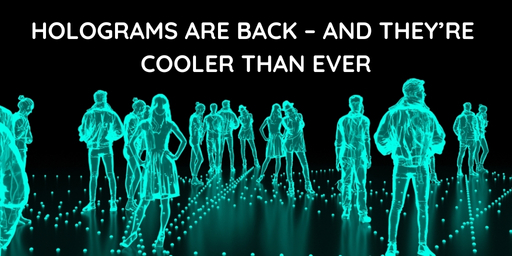If your childhood is full of Star Wars, Iron Man, or old-school sci-fi cartoons, and the hidden child in you always wanted to send a holographic message attending a meeting via 3D projection, or interacting with floating, life-like visuals. Back then, it felt like pure fiction.
Now, holograms are no more a dream. They’ve returned, and this time they are cooler than one can ever imagine.
The Hologram Comeback
Holography is not a new concept. It was invented in the 1940s and gained attention in the 60s. But the hype faded because early holograms were expensive, low-quality, and limited in use.
With the advancement in display technology, AI, 5G and mixed reality, hologram staged an epic comeback. They’re more interactive, hyper-realistic, and accessible—breaking out of the lab and landing in our daily lives.
Where Holograms Are Wowing Us
- Concerts & Live Events
Remember when a holographic Tupac performed at Coachella in 2012? That was transitioning, since then holography has evolved significantly. Today, artists are performing in multiple cities at once, even bringing the legends to life, all with holograms.
- Virtual Meetings & Conferences
Leave awkward Zoom calls—organisations are testing hologram tech to bring life-size 3D versions of employees right into the boardroom. You can interact with holographic people, make eye contact, and body language as if they are present in real life.
- Education & Training
From anatomy lessons that let medical students “walk through” the human body, to engineering classes where you can interact with a 3D model of a rocket engine, holograms are transforming learning into an immersive, hands-on experience.
- Retail & Advertising
Imagine walking into a store and being greeted by a holographic assistant who can answer questions, suggest products, and even demonstrate how something works—without needing a real human present. Retailers are already experimenting with this tech to stand out and engage customers.
- Sports & Entertainment Broadcasting
Sports broadcasters are now using holograms to break down strategies in 3D, teleport commentators onto the field, and bring fans closer to the action. Result? Engaging and exciting content.
Why They’re Cooler Now
Ultra-Realism: All thanks to AI and photo rendering, modern holograms are similar to reality.
Interactivity: You can now touch, rotate, and manipulate holograms in real time.
Portability: Portable projectors and AR glasses are making holograms possible without massive, expensive setups.
Speed: With the help of 5G, holographic data streams instantly, making live communication smooth and glitch-free.
What’s Next for Holograms?
The possibilities are endless. We can enjoy holographic sports games, fashion brands walking the ramp globally, or doctors all in the comfort of our living room. Imagine a world where you can make jokes with holograms, play video games and can learn too.
The metaverse too can get a tangible upgrade with holograms, blurring the line between physical and virtual world.
Cool Factor Meets Real-World Impact
Yes, holograms are quite futuristic, but their potential is far away from being “wow”. They can be helpful in healthcare, disaster zones, rescue missions etc. And for global businesses, they offer a sustainable alternative to frequent travel—cutting costs and reducing carbon footprints.
Holograms are evolving faster than anyone can imagine. The bridge from static, grainy images to interactive, high-definition, 3D experiences has turned them from novelty to necessity in several industries.
From next time someone tells you holograms are just a gimmick, remember: they’re changing how we learn, work, shop, and connect. The future is here, and it’s standing right in front of you… in 3D.

